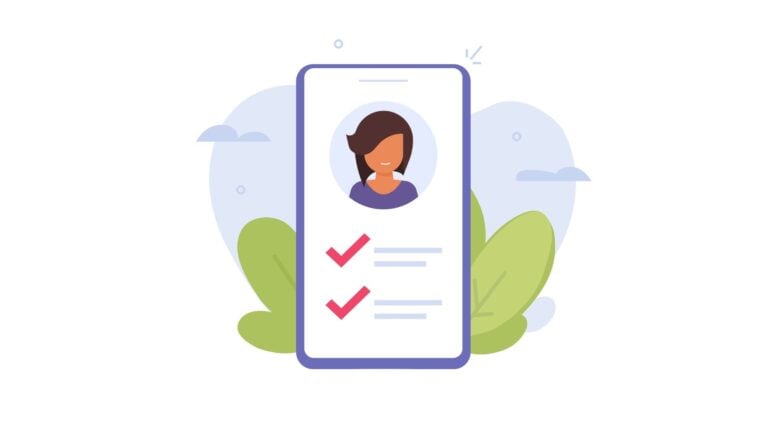Employee assessments are performance reviews designed to help employees develop professionally. We explain best practices for conducting employee assessments and highlight top assessment tools to use.
It’s difficult to know if your team is performing at its best if you don’t measure your employees’ performance and skills from time to time. Employee assessments offer a way to holistically evaluate your employees, provide feedback on their performance, and help them develop professionally.
There are many ways to approach employee assessments, including using software to guide your evaluations. In this guide, we explain everything you need to know about employee assessments, cover best practices to follow, and highlight our favorite tools that can help you along the way.
Key Takeaways
- An employee assessment enables you to evaluate a worker’s performance, including their strengths and weaknesses.
- Assessments are valuable for benchmarking team members’ performance, identifying opportunities for improvement, and setting goals.
- They can also boost employees’ morale and help you identify candidates for promotion.
- To conduct an employee assessment, start by collecting performance data and identifying an employee’s strengths and weaknesses. Then, meet with an employee for a conversation and follow up with regular check-ins.
What Is an Employee Assessment?
An employee assessment is a formal process for evaluating an employee’s job performance and skills. Many companies evaluate their employees on an annual basis, but others many choose to conduct evaluations more often.
An employee assessment can take many different forms. For example, it may include skills tests, interviews, feedback from colleagues, and more.
Assessments can be used to benchmark an employee’s performance or identify potential areas for professional development. They can also be conducted as part of a compensation review or consideration for promotion or termination.
Who Uses Employee Assessments?
Businesses of all sizes can benefit from conducting employee assessments. In large businesses, assessments provide a way to ensure that no employee falls through the cracks. In smaller businesses, assessments provide a structured way to review employees and identify growth opportunities.
Employees in different job roles may use assessments in different ways.
- Managers can use employee assessments to evaluate the performance of their team members.
- High-level managers and executives can use assessments to identify candidates for promotion.
- HR staff can use assessments to determine what skills and qualities are needed in a role.
- Hiring managers and recruiters may assess job candidates using many of the same tools and techniques that are used for employee assessments.
- For employees being assessed, assessments offer a chance to understand their own strengths, weaknesses, and areas for development.
What Are the Benefits of Employee Assessments?
Benchmark an employee’s performance
Employee evaluations offer a way to measure and benchmark an employee’s performance. For example, if your assessment includes a skills test, you can directly measure an employee’s performance on that test over time. If you include subjective feedback in your assessment, you can look at how your feedback for an employee changes from year to year.
Set and evaluate goals
Many companies incorporate goal-setting into their employee reviews.
You and your workers should set goals collaboratively. Ideally, each goal should be accompanied by a plan for how the employee will achieve it.
During the next employee assessment, you and your employees can reflect on whether each goal was met. You can add new goals or discuss ways to remedy problems if certain goals weren’t achieved.
Identify opportunities for training and professional development
An employee strength assessment can help identify areas in which a worker needs additional training. For example, if your employee’s skills test shows that they don’t fully understand a company process, you could provide them with extra training for it.
Assessments can also help you and your employees identify opportunities for professional development. An employee may have a subject area or software that they want to explore, for example, and they can bring this up with you during their review.
🧠 Did You Know?
With Connecteam, you can create custom training courses—using templates or from scratch—in minutes. Workers can complete training on the go at their own pace, and you can track their progress every step of the way.
Opportunity for honest conversations
When day-to-day work is busy, it’s easy to put off addressing problems in the workplace.
An employee assessment offers a chance to focus on problems and talk about them honestly. You and your employee can sit down, address the issue, and find productive ways to move forward.
Clarify job responsibilities and expectations
During a staff assessment, you and your employees can talk about more than just their performance. You can also look critically at the duties of their jobs.
This is a good opportunity to address any changes to the scope of employees’ roles. If a worker has taken on additional responsibilities that weren’t in their original job description, you can discuss ways to reduce these responsibilities and/or provide additional compensation to them.
Your employee can also ask you questions about their job duties to clarify expectations. This is especially important for newer employees or employees who have recently been promoted to a new role.
Boost employee morale
Assessments are also a chance to recognize and reward employees for strong performance. You can identify areas where an employee has excelled and discuss the impact their work has had on the company.
This praise can go a long way towards boosting employee morale and encouraging top employees to stay with your company.
🧠 Did You Know?
Connecteam enables you to recognize employees with achievement badges and digital tokens they can exchange for gift cards.
Identify candidates for promotion
After employee assessments, you can pass documents from them to HR managers and higher-level managers for review. Even if they don’t interact with your employees regularly, these supervisors can then identify candidates for promotion.
This is good for top-performing employees, who can get noticed and promoted. It’s also good for your company, which can better reward, retain, and promote your best employees.
Types of Employee Assessments
There are several different types of employee assessments. Your business can use just one type, but using different types together can give you a more holistic view of your employees.
Performance evaluations
These are the most commonly used assessments. They typically involve a one-on-one interview between you and an employee to discuss their strengths, weaknesses, and goals. They may also include gathering feedback from the worker’s colleagues.
Many companies choose to conduct employee performance assessments annually or semi-annually.
Skills assessments
These are more narrowly focused than performance evaluations. Typically, they’re designed to test an employee’s hard skills, like job-specific skills or the ability to use certain software or machinery. They can also test soft skills like leadership and communication.
Skills assessments can be used to identify areas where an employee could benefit from additional training or professional development.
Personality tests
Personality testing can provide insights into an employee’s personality, including their preferred work style and motivation.
This type of employee assessment is most commonly used when a business is trying to understand or change its company culture. It can also be helpful if your team is experiencing friction between coworkers.
📚 This Might Interest You:
Check out our list of tips to overcome negativity in the workplace.
Cognitive ability tests
Cognitive ability testing evaluates an employee’s logic and reasoning skills. This type of testing can, for example, measure an employee’s ability to prioritize tasks or quickly solve numerical problems.
Cognitive ability tests may provide useful insights if you’re considering promoting an employee to a new role with different responsibilities.
How to Conduct an Employee Assessment
Step 1: Collect performance data
The first step in conducting an assessment of employees is to collect data about their performance.
This can include specific, measurable metrics like key performance indicators that you and your employee have discussed previously. If you and your employee set goals during your last performance evaluation, assess whether each goal was met.
Performance data can also be subjective. For example, you can create categories such as attitude and communication and rate an employee in each of these categories on a scale from 1 to 10. You can look at an employee’s job description to decide what categories to rate in your assessment.
It’s a good idea to also ask the employee to rate themselves in each of these categories. This way, you can quickly identify discrepancies between how you and your workers perceive their performance.
Depending on the employee’s job responsibilities, it can also be helpful to ask their colleagues to rate the individual or provide feedback on their performance.
Step 2: Identify strengths, weaknesses, and goals
Based on the performance data you collected, you should be able to conduct an initial assessment of your employee.
Write down their strengths and weaknesses, including specific examples of tasks or job duties they’ve performed well or poorly. It can also be helpful to write a summary of what an employee does well and where they could improve.
Next, write down goals that you think the employee should pursue between this assessment and the next. Keep in mind that some of the goals from your last assessment may be ongoing.
💡 Pro Tip:
It can be helpful to send these notes to your employee before you meet with them. This way, your employee has a chance to think about your feedback ahead of time.
Step 3: Have a discussion
At this point, it’s time to have a meeting with your employee. You should frame this meeting as a 2-way discussion in which you will both be engaged.
During the meeting, you can discuss your ratings in each of the assessment categories you created. If there are big discrepancies between your ratings and your employee’s self-ratings, it’s important to have a conversation about the mismatch.
You can also discuss each of the employee’s strengths and weaknesses that you identified. Remember to be constructive. You and your employee should work together to identify ways to resolve any of the weaknesses that have been identified. This could include additional training, shifting work responsibilities, or another solution.
Finally, discuss the employee’s goals from your last assessment and whether they were met. You can then decide together on new goals, which may include modifying the goals you laid out ahead of your meeting. Be clear about what you expect from your employee to meet these goals and how you will support them to do so.
💡 Pro Tip:
Ensure you set goals that are SMART: specific, measurable, achievable, relevant, and time-bound. Read our in-depth guide on SMART goals for employees—including how to implement them.
Step 4: Schedule check-ins
A formal employee assessment may only happen every 6 or 12 months. That’s a long time between assessments—and if an employee gets off-track on their goals in that time, it’s much better to address the problem sooner rather than later.
Thus, it’s a good idea to schedule regular check-ins with each employee. These can be less involved than a full performance evaluation but should give you both a chance to ensure the employee is on track to meet their goals.
Tools to Use for Employee Assessments
While you can conduct employee assessments with just a pen and paper, you’ll get more valuable insights out of your evaluations by using digital tools to help.
Here are some of the best employee assessment tools to use.
Surveys
Surveys can form the basis of an employee evaluation. You can create performance categories that you want to evaluate for your team members. Then, respondents can provide a numerical rating or written feedback for each category.
One of the nice things about using surveys for performance evaluations is that you can keep the format consistent for each employee you’re reviewing—and from year to year. Just remember to adjust your survey as your team’s performance metrics change.
Another benefit to using surveys is that you can easily send them to an employee’s colleagues to gather additional data. If you use a platform like Connecteam, you can view all of your survey results in one place to get a full view of what your team thinks about a worker’s performance.

Self-assessments
A self-assessment can be a questionnaire that you send to an employee to ask them to evaluate their performance. It can include open-ended questions that ask about how the employee feels they have performed, what they feel is holding them back, and what their long-term career goals are.
Psychometric assessments
Psychometric assessments include personality tests and cognitive ability tests. It’s a good idea to use a professionally created test that’s based on the latest science so you can trust the results you get and feel confident in interpreting them.
There are many psychometric testing platforms available for businesses.
Quizzes
Quizzes are helpful for assessing employees’ technical skills, such as proficiency with a company procedure or a piece of software. Using software like Connecteam, you can build quizzes that are specific to an employee’s job duties.
Employee assessment software
Employee assessment platforms are all-in-one software packages that combine surveys, self-assessments, quizzes, and other tools for reviewing employees. They can streamline the process of conducting employee assessments and help you analyze your results.
Connecteam is the most effective employee assessment software for companies of all sizes.
Our software makes it easy to create quizzes, self-assessments, and feedback surveys. It also includes a built-in work chat so you can follow up with employees and answer questions at any time.
Connecteam’s employee timelines are especially powerful for conducting assessments. You can review any employee’s previous evaluations, raises, promotions, certifications, project milestones, and more. You can also attach files to any timeline event, making it easy to keep track of assessment-related documents.
Connecteam is free for businesses with up to 10 employees. Larger businesses can use Connecteam starting at only $29 per month for up to 30 employees, plus $0.50 for each additional employee.
Get started with Connecteam for free today and conduct better employee assessments.
Tips for Effective Employee Assessments
Be honest and clear
Talking to an employee about their weaknesses or times they underperformed can feel awkward. However, it’s important to be honest, direct, and clear during your conversation.
Your employee should understand how they fell short and what they can do to meet your expectations in the future. It’s a good idea to ask employees directly if they understand your feedback and to encourage them to ask questions.
Avoid criticizing personality traits
When discussing an employee’s weaknesses, it’s important to focus on their actions rather than their personality traits.
For example, instead of telling an employee that they are brusque, you could give examples of poor communication that they’ve had and explain why these examples were unprofessional.
Always be constructive in your criticism by providing potential solutions.
Don’t compare employees against one another
As much as possible, avoid comparing employees against each other during your assessment. You can use another employee as an example without naming them. Specifically naming an employee can create tension between colleagues, even if that isn’t your intention.
Document goals
Once you and your employee have agreed on goals, be sure to send the employee a copy of them.
You can also ask them to acknowledge the goals—by signing the document, sending you an email, or any other method of confirmation you prefer. That way, there’s no chance of miscommunication over what they should be focusing on.
Conclusion
An employee assessment is a formal process for evaluating an employee’s performance. These assessments can be very valuable for setting goals, identifying opportunities for improvement, and engaging employees.
There are many tools you can use to help conduct employee assessments, including surveys, quizzes, and self-assessments. To streamline the process, consider using dedicated employee assessment software like Connecteam.
Get started with Connecteam for free today!
FAQs
How are employee assessments used in the workplace?
Employee assessments can be used to document an employee’s performance, reward them for good work, and identify opportunities for improvement. Companies can also use assessments to identify candidates for a raise or promotion.
How often should you conduct employee assessments?
Most businesses conduct employee assessments on an annual or semi-annual basis. In between assessments, you should conduct regular check-ins with your employees to ensure they are on track to meet their goals.



